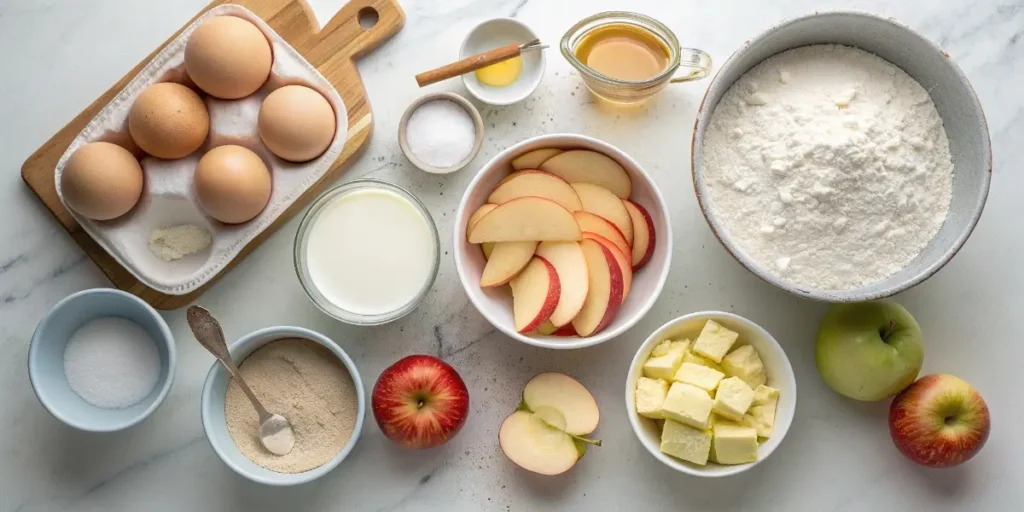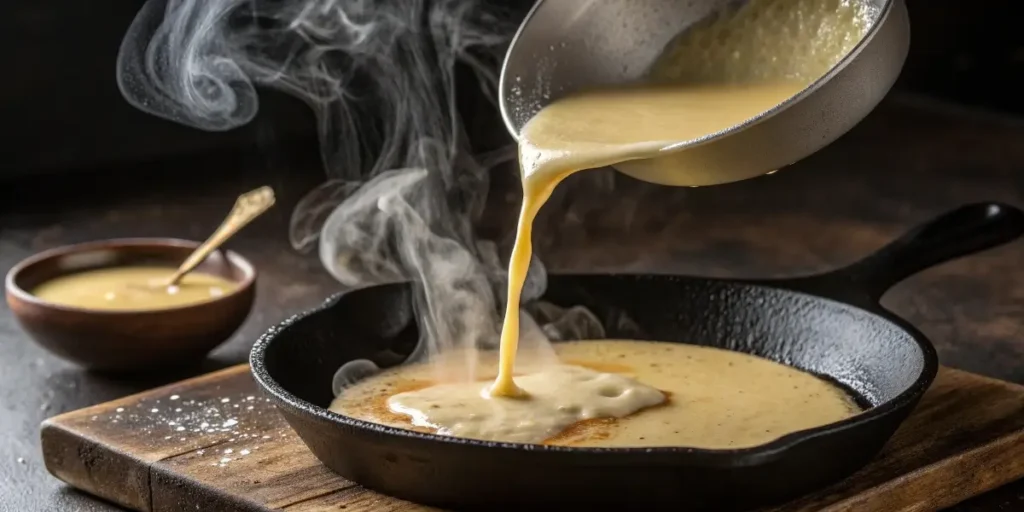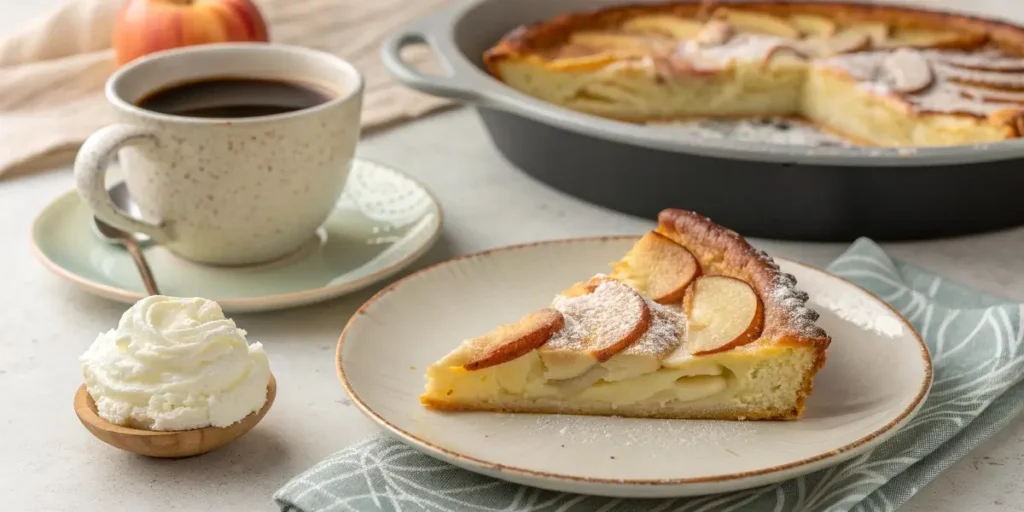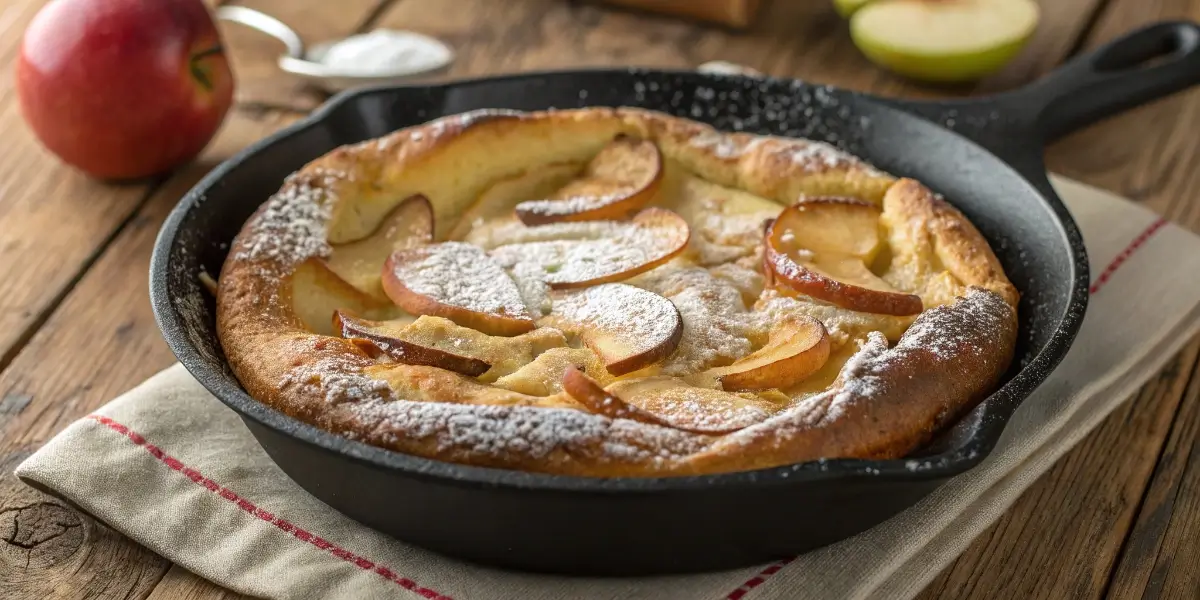Apple Dutch Baby Recipe – The Perfect Puffy Oven Pancake
The apple Dutch baby recipe is one of those breakfast miracles that feels fancy but comes together effortlessly. This golden, puffed pancake baked in a hot skillet rises dramatically in the oven, creating crisp edges and a soft, custard-like center filled with caramelized apples. Whether you’re hosting a weekend brunch or craving a cozy fall breakfast, this recipe delivers both flavor and flair. In this guide, you’ll learn how to make the perfect apple Dutch baby, discover the science behind its fluffiness, explore variations, and get answers to the most common questions about this beloved oven pancake. Looking for inspiration? Try delicious brioche French toast casserole for another decadent breakfast idea.
Table of Contents
What is an Apple Dutch Baby Recipe?
The Origins of the Dutch Baby Pancake
The Dutch baby, sometimes called a German pancake, has an interesting history. Despite its name, it’s not actually Dutch—it’s inspired by the German dish known as Apfelpfannkuchen, which translates to “apple pancake.” The term “Dutch baby” was popularized in the early 1900s by a Seattle restaurant called Manca’s Café. The owner’s daughter supposedly coined the term “Dutch baby” as a mispronunciation of “Deutsch,” the German word for “German.” Since then, this oven-baked pancake has become a staple across American breakfast tables, particularly in cozy diners and brunch cafés.
Traditionally made with eggs, milk, flour, and butter, a Dutch baby relies on steam rather than baking powder or soda for its impressive rise. When apples are added, the result is a delightful twist on the classic—a caramelized, fruit-infused version that brings together the best of pancakes and pie.
Why the Apple Version Became a Breakfast Favorite
So why has the apple Dutch baby recipe become such a crowd-pleaser? The answer lies in its comforting combination of flavors and textures. Sweet, tart apples sautéed in butter and cinnamon provide a contrast to the airy, custardy pancake. The apples caramelize slightly during baking, creating a rich layer of flavor that pairs beautifully with powdered sugar, maple syrup, or a drizzle of caramel.
Unlike traditional stovetop pancakes that need constant flipping, this recipe is hands-off once it’s in the oven. You can relax while the magic happens—and in about 20 minutes, your kitchen fills with the scent of baked apples and vanilla. Don’t miss our almond flour apple cake for another fruit-forward treat with a wholesome twist.
Apple Dutch babies are also highly versatile. They can be served sweet with toppings like whipped cream and honey or made slightly savory with a touch of cheddar and herbs. Whether you enjoy it fresh from the skillet or cooled slightly for dessert, it’s always an impressive and satisfying dish.
Ingredients Needed for the Best Apple Dutch Baby
Essential Pantry Staples
Making the perfect apple Dutch baby recipe starts with simple pantry staples you likely already have. The batter is a mix of eggs, flour, milk, and butter — the foundation for that iconic puff. Eggs give structure and rise, flour adds body, and milk keeps the texture custardy. Melted butter brings a rich, golden flavor that ties it all together.

You’ll also need a bit of sugar, vanilla extract, and salt to balance sweetness and flavor. A touch of cinnamon or nutmeg in the batter adds warmth, complementing the apples beautifully. Use whole milk for the creamiest texture, but almond or oat milk works too if you prefer a lighter version.
Before mixing, make sure all your ingredients are at room temperature. Cold milk or eggs can cause the batter to be dense and less airy. A quick blend in a blender or whisk by hand until smooth ensures a silky, lump-free mixture ready for baking.
Choosing the Right Apples for Dutch Baby Perfection
Not all apples bake the same. For this recipe, you’ll want apples that hold their shape and offer a balance of tartness and sweetness. Honeycrisp, Granny Smith, or Pink Lady apples are ideal choices. They caramelize beautifully without turning mushy in the oven.
Slice your apples thinly so they cook evenly. A quick sauté in butter and brown sugar before baking enhances their flavor and ensures a golden, glossy finish. This step is optional but highly recommended — it adds depth and prevents the fruit from releasing too much moisture during baking.
For an even more irresistible twist, sprinkle a bit of cinnamon sugar on top before sliding your skillet into the oven. It forms a light crust and infuses the pancake with that cozy fall aroma.
Check out our peach blueberry cobbler if you love fruit-forward desserts with a similar sweet, caramelized flavor profile.
Step-by-Step Guide to Making a Fluffy Apple Dutch Baby
Preparing the Batter the Right Way
A flawless apple Dutch baby recipe depends on how well you mix and rest the batter. Start by whisking together eggs, milk, flour, sugar, vanilla extract, and a pinch of salt until smooth. Using a blender works even better, creating a silky batter with tiny air bubbles that help the pancake rise beautifully in the oven.
Let the batter rest for 10–15 minutes. This step allows the flour to hydrate and the gluten to relax, giving your Dutch baby a tender, custard-like texture inside and crisp edges outside. While the batter rests, preheat your oven to 425°F (220°C) with a cast iron skillet inside. A hot skillet is crucial—it’s what triggers the dramatic puff as the batter hits the pan.
Melt unsalted butter in the heated skillet, swirling it to coat the bottom and sides evenly. Quickly pour in the batter and top with the sautéed apple slices. Work fast—the hotter the pan, the higher the rise.

The Secret Baking Method for a Perfect Puff
The secret to a fluffy Dutch baby lies in high heat and timing. Bake for 18–22 minutes, without opening the oven door. Steam is what makes the pancake rise, and opening the door too soon can cause it to collapse. Watch through the glass instead—the edges should puff up dramatically and turn golden brown while the center remains tender and slightly custardy.
Once baked, remove the skillet from the oven and dust your pancake with powdered sugar. You can also drizzle with maple syrup, caramel sauce, or a squeeze of lemon juice for a bright contrast. Serve immediately—Dutch babies are best enjoyed hot and fresh while their lofty shape still holds.
Don’t miss our red velvet waffles recipe for another indulgent brunch idea with an impressive presentation.
The Science Behind a Fluffy Dutch Baby
How Steam Creates That Signature Rise
The magic behind a fluffy apple Dutch baby recipe lies in simple kitchen chemistry. Unlike pancakes or cakes that use baking powder or soda, a Dutch baby relies solely on steam and trapped air. When the batter hits the hot skillet, the liquid ingredients—especially eggs and milk—create steam. That steam expands rapidly in the oven’s heat, pushing the batter up the sides of the pan and forming those iconic puffy edges.
Eggs play a major role here. They give the pancake structure and elasticity, allowing it to stretch and hold air without collapsing. The flour then locks that structure in place, creating the perfect balance between crispness and softness. The result? A pancake that’s crisp around the rim but custard-like in the center—a texture no other breakfast dish quite matches.
To keep that rise consistent, make sure your skillet is thoroughly preheated before pouring in the batter. Even a few degrees off can mean the difference between dramatic puff and a flat pancake.
Tips for Achieving the Ideal Texture and Flavor
Getting that bakery-quality Dutch baby at home isn’t complicated if you follow a few pro tips. First, blend your batter until smooth, but don’t overmix—it can make the pancake dense. Resting the batter, even for 10 minutes, allows the gluten to relax and the starches to absorb liquid evenly, improving both flavor and texture.
Next, use the right skillet—cast iron works best because it retains heat evenly and helps form that golden crust. Also, bake in the center rack of your oven for the most even rise.
Once baked, resist the urge to leave it in the pan for too long. Remove the Dutch baby immediately to a serving plate to preserve its crisp edges. Then finish with toppings like caramelized apples, cinnamon sugar, or a dollop of whipped cream.
If you love experimenting with oven-baked dishes, check out our sourdough French toast bake for another airy, custard-style breakfast.
Variations and Flavor Enhancements
Adding Cinnamon, Nutmeg, or Brown Sugar
Once you’ve mastered the basic apple Dutch baby recipe, you can easily elevate it with spices and flavor boosters. Classic warm spices like cinnamon, nutmeg, and allspice bring out the natural sweetness of the apples while giving your pancake a cozy, aromatic note. A teaspoon of cinnamon and a pinch of nutmeg added to the batter can transform your Dutch baby into a fall-inspired delight.
For extra richness, swap out regular sugar for brown sugar. Its molasses undertone pairs beautifully with caramelized apples and gives the pancake a slightly deeper color. You can even mix cinnamon and brown sugar to sprinkle over the top before baking—it melts into a glossy, lightly crisp glaze that looks as good as it tastes.
Feeling bold? Add a hint of vanilla or almond extract for an elevated flavor profile. These simple tweaks turn a good Dutch baby into something truly unforgettable.
Creative Toppings: From Caramel Apples to Whipped Cream
The beauty of an apple Dutch baby recipe lies in its versatility. You can keep it classic with powdered sugar and maple syrup, or dress it up with decadent toppings. Try sautéed apples tossed in butter, brown sugar, and a touch of cinnamon for a rich caramelized layer that melts into the pancake’s surface.
Another crowd-favorite topping is whipped cream with a drizzle of honey or salted caramel sauce. For a nutty crunch, sprinkle toasted pecans or sliced almonds just before serving. Want something lighter? Top your Dutch baby with Greek yogurt and fresh berries for a refreshing brunch twist.
If you enjoy creative desserts, check out our cinnamon pull-apart bread guide for another cinnamon-rich bake.
Serving Suggestions and Pairings

Breakfast, Brunch, or Dessert – When to Serve It
An apple Dutch baby recipe fits almost any occasion. Its light, custardy texture and warm apple flavor make it a versatile dish you can serve for breakfast, brunch, or even dessert. For mornings, it pairs perfectly with a cup of coffee or spiced chai. During brunch gatherings, slice it into wedges and serve it family-style right from the skillet—it’s guaranteed to impress your guests.
If you prefer it as dessert, top it with a scoop of vanilla ice cream or a drizzle of caramel sauce for an indulgent finish. The slightly crispy edges balance beautifully with the creamy sweetness, creating a flavor combo that’s both comforting and elegant. No matter when you serve it, the aroma of baked apples and butter will fill your kitchen with a cozy, homemade charm.
Best Drinks and Sides to Pair With an Apple Dutch Baby
Choosing the right sides and drinks can turn your apple Dutch baby recipe into a complete meal. For something light, serve it alongside Greek yogurt, bacon, or fresh fruit salad. The creamy tang of yogurt and the saltiness of bacon contrast nicely with the sweet, soft pancake.
As for drinks, freshly brewed coffee, hot chocolate, or apple cider make excellent companions. If it’s brunch, a glass of mimosa or sparkling apple juice adds a festive touch.
Want more pairing inspiration? Check out our white hot chocolate recipe for a cozy winter pairing that complements the cinnamon and apple flavors.
Nutrition and Storage Tips
Nutritional Breakdown of a Homemade Apple Dutch Baby
The apple Dutch baby recipe is indulgent yet surprisingly balanced. A single serving typically contains around 250–300 calories, depending on your toppings and portion size. The bulk of the calories come from eggs, milk, and butter, which also provide valuable protein and healthy fats. Apples add natural sweetness and fiber, reducing the need for extra sugar.
Here’s a quick nutrition breakdown per serving (without toppings):
| Nutrient | Amount |
|---|---|
| Calories | 280 kcal |
| Protein | 8 g |
| Fat | 12 g |
| Carbohydrates | 34 g |
| Fiber | 3 g |
| Sugar | 15 g |
This makes it a hearty breakfast or brunch option that feels indulgent but still provides real nourishment. To make it lighter, you can substitute almond milk for regular milk or use whole wheat flour for added fiber.
How to Store and Reheat Leftovers Without Losing Fluffiness
Although a Dutch baby is best enjoyed fresh out of the oven, leftovers can still taste wonderful with the right storage. Let the pancake cool completely, then store slices in an airtight container in the fridge for up to 2 days. To keep it from getting soggy, avoid adding syrup or toppings before refrigerating.
When reheating, use an oven or toaster oven at 350°F (175°C) for 5–7 minutes. This helps bring back its crisp edges and warm, custardy interior. Avoid microwaving—it tends to make the pancake rubbery and flat.
If you want to prep ahead, mix the batter the night before and refrigerate it overnight. Just whisk it briefly in the morning before baking. For another make-ahead idea, check out our delicious make-ahead french toast casserole that saves time and still delivers that bakery-quality flavor.
Conclusion – Mastering the Apple Dutch Baby Recipe at Home
A perfect apple Dutch baby recipe blends simple ingredients with the right technique. Always preheat your oven and skillet before pouring in the batter, use room-temperature ingredients, and resist opening the oven while it bakes. That’s how you get those lofty, golden edges and a soft, custardy center.
Let your batter rest for at least ten minutes, and choose apples that hold up well during baking—like Honeycrisp or Granny Smith. A sprinkle of cinnamon sugar or a drizzle of maple syrup adds that finishing touch everyone loves. Once you master the method, this oven pancake becomes a go-to favorite for weekend breakfasts, cozy brunches, and even impromptu desserts.
If you enjoy warm, comforting bakes like this, check out our healthy apple crumble recipe for another easy fruit-filled treat. Don’t miss our irresistible banana waffles—a delicious twist for your next brunch.
FAQs
What’s the Secret to a Fluffy Dutch Baby?
The secret to a perfectly fluffy apple Dutch baby recipe lies in three key steps: a hot skillet, room-temperature ingredients, and high oven heat. When you pour the smooth, rested batter into a sizzling pan, steam forms instantly, causing the batter to puff dramatically. Using eggs at room temperature helps the batter expand more evenly, while preheating your cast iron skillet ensures those signature crisp edges.
Avoid opening the oven door while baking—the rush of cool air can deflate your Dutch baby before it sets. A touch of butter and whole milk also contribute to that rich, golden texture.
Why Do They Call It a Dutch Baby?
Despite the name, a Dutch baby isn’t Dutch at all—it’s American! The name likely originated from a mispronunciation of “Deutsch,” which means “German.” The dish itself is based on a German pancake called Apfelpfannkuchen, often made with apples, sugar, and eggs. When the recipe gained popularity in Seattle in the early 1900s, it was coined “Dutch baby” and has been known that way ever since.
What’s in a Dutch Baby?
A traditional Dutch baby contains just eggs, milk, flour, sugar, butter, and salt—simple ingredients that create extraordinary results. For the apple version, you’ll also add sliced apples, brown sugar, and cinnamon, which caramelize during baking for a dessert-like finish. The magic comes from the balance of airiness, sweetness, and that golden, puffed crust.
How Does a Dutch Baby Taste?
Imagine a mix between a pancake, crepe, and custard. That’s the flavor and texture of an apple Dutch baby recipe. The edges are buttery and crisp, while the center stays soft, slightly eggy, and infused with sweet, spiced apples. It’s comforting without being overly sweet, and every bite feels like a cozy, homemade treat.
What Is the Difference Between a Dutch Baby and Clafoutis?
Though they look similar, a Dutch baby and clafoutis are quite different. A Dutch baby is light and puffy, made with more eggs and cooked in a skillet. A clafoutis, on the other hand, has a denser, custard-like consistency and is typically baked with cherries or other fruits directly in the batter. The Dutch baby rises higher and feels more like a breakfast dish, while clafoutis is often served as dessert.
What Is the Very Yummy German Treat Apfelpfannkuchen in English?
Apfelpfannkuchen translates directly to apple pancake in English. It’s a close cousin to the Dutch baby, though usually cooked on the stovetop rather than baked. The apple Dutch baby can be seen as the oven-baked American version of this traditional German dish. Both share the same comforting sweetness, soft apple layers, and touch of cinnamon that make them irresistible.

